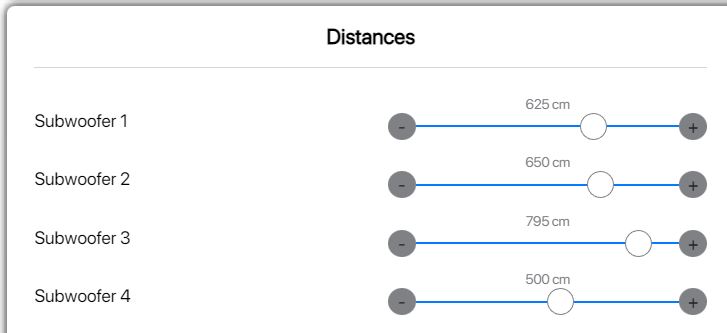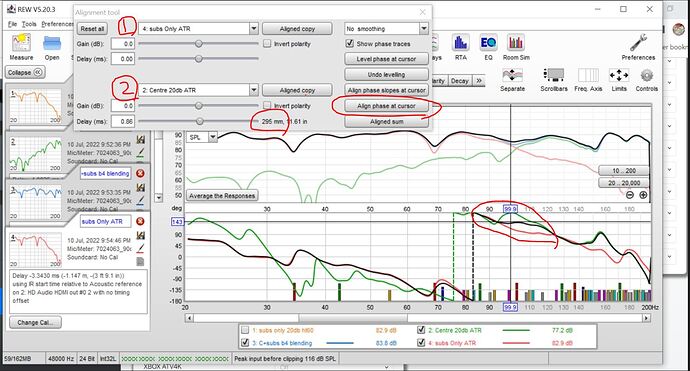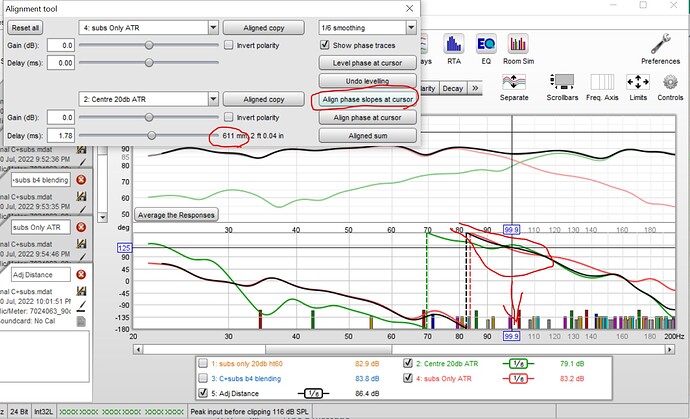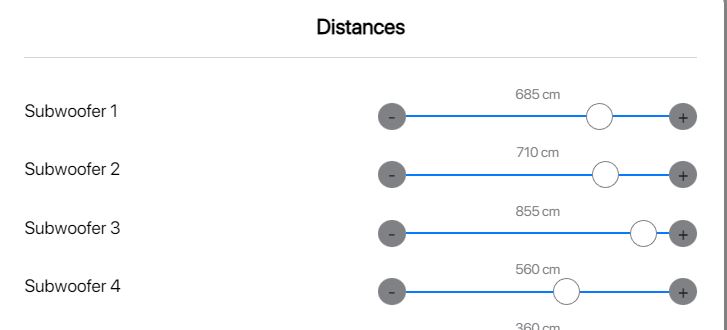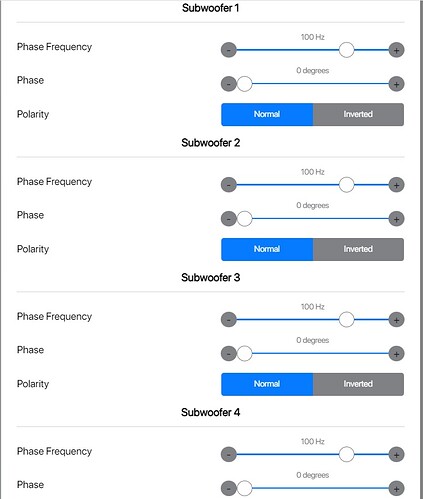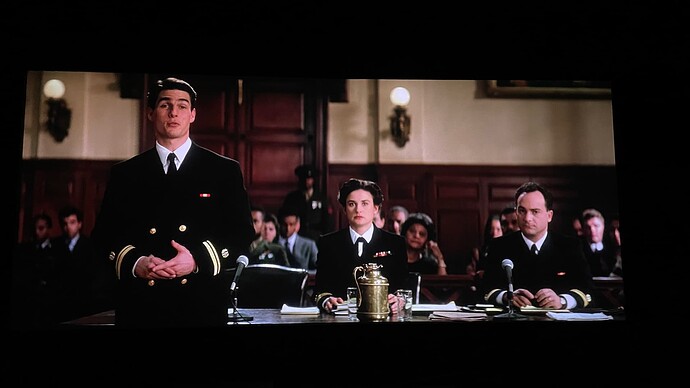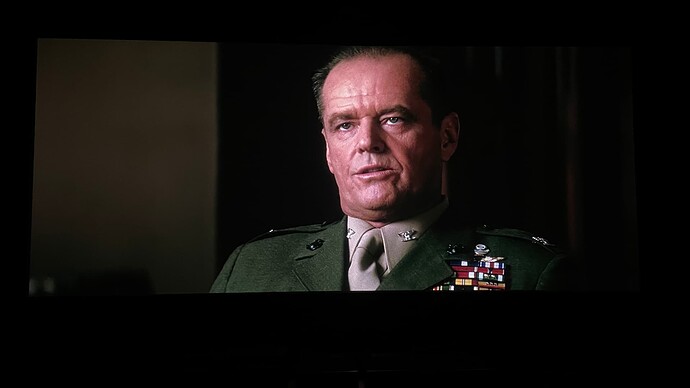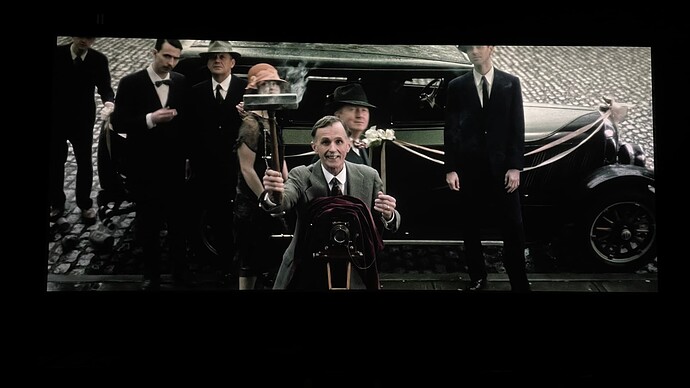What version of the ARC Genesis your friend is using? Did he remember to enter the physical distance for the front left speaker?
arc genesis 1.6.10.
yes he measured the physical distance for the front left speaker
The subwoofer distance was a whopping 9.75m?! That’s a far stretch. May I inquire how big is the listening area? What is the physical distance from the MLP to the front left speaker?
Continuing from where i left off, Crowsons Integration. With that out of the way, its time to look at the blending of all speakers with all subs
Auto Phase Correction (Stage 2) post ARC calibration
I think there is a lot of misunderstanding from the folks who are new with this Anthem feature. The auto Phase correction feature, works with blending the subwoofers to the Mains. That is its sole purpose. At this stage now, it is no longer blending the subwoofers or the mains, but rather, blending both of them because of this sole reason stated below.
Do note at this stage, it is no longer applying any FIR correction filters. but merely shifting phase so the subs and mains have a phase slope that sums up perfectly at the Crossover Region. Thats about it with this auto phase feature. Based on my personal experience, i have found that it doesnt really do a good job at blending the mains to subs. So i will now share how i have done this, using the manual approach that blends everything perfectly, including alignment in the time domain. This involves the use of REW and measurement skills. So ill get down to the technical side of things for those who are keen to use this approach for the time being, until ARC come out with 1.6.11 that hopefully fixes this issue
Copied and paste from Rythmik site below for better understanding
Quote:
Linkwitz Riley filters
The filter setup in today’s HT receiver is based on Linkwitz-Riley filters. Linkwitz and Riley published a AES paper describing a family of filters boasting excellent phase alignment and therefore dispersion pattern. They found if one uses a 4th order HP built with two cascading Butterworth 2nd order filters (with Q=0.7), and a 4th order LP built with also two cascading Butterworth 2nd order filter (with Q=0.7), the two sides of the crossover will be in phase.
Arguable the most significant contribution is the concept of phase alignment over a wide bandwidth. For bass frequencies in particular, it’s not merely about amplitude response. To implement a L-R filter, the HT receiver uses a 2nd order (12db/octave) high pass filter, and a 4th order (24db/octave) low pass filter. A high pass filter cuts frequencies below a chosen corner frequency, and a low pass filters above.
You may notice that they are not symmetrical. The reason is that we must also consider the acoustic roll-off of the main speakers. In this case, it is assumed that they are sealed, and as a result will have a 2nd order roll-off. If the speakers are in fact vented, the roll-off will have a steeper 4th order slope. In order to achieve a correct integration, the summed roll-off slopes of the main speakers and subwoofer should be symmetrical once the acoustic and crossover filters are added.
Consider the example of an 80 Hz crossover point. If the main speakers have a sealed box which are -3db at 80 Hz, the acoustic roll-off will be 2nd order. When this speaker is set to “small,” in the receiver settings, it will have a 2nd order high pass filter at the crossover point of 80 Hz. The summed roll-off is therefore 4th order. The subwoofer should then have its crossover set to 80 Hz and use a 4th order low pass filter. This will yield a correctly implemented 4th order crossover. At 80 Hz, the response of the subwoofer and the mains will each be -6db.
Unquote:
Not a malfunction, simply that one of the speakers in the room has run out of distance for correction. So just click “ignore” and ARC will apply relative delays instead. Still correct, nothing wrong.
Relative delays refers to acoustical delays applied relative to a specific speaker
Lets go and lets see how we can do the manual blending between mains and subs. This is a 10mins process and is faster than the auto phase ![]()
This approach can be used for any processor, need not be anthem with the condition you have the tools and know how to measure with REW. It takes all the guessing out the window and will be pin poin 100% correct everytime., i mean it, every single time.
The first thing we need to understand post calibration, is the distance applied for all subwoofers. In my case, this is the result below
Next we need to measure Centre Channel only, 20hz to 200hz, without the subwoofers playing using Acoustic Timing Reference feature. I used right speakers as the reference speaker. That means channel 3 on REW with all subwoofers powered off. Im using trigger 1 to trigger all 4 subwoofers. So switching off trigger 1, will switch off all subwoofers the same time.
Once you have your centre channel measured. It is time to power off centre channel, and turn on all subwoofers. Now we need to measure all subwoofers through channel 3 using acoustic timing reference, because they have a XO applied, in my case, I cross everything at 100hz. (ill explain why this is the best approach). So since 100hz is applied, this means bass <100hz is sent to the subwoofers. When centre channel is muted, you are actually measuring the subwoofers. When you have both measurements with its acoustic timing reference information, its time to look at the alignment tool
PS: Do not use Channel 4 LFE to measure, that doesnt have the filters applied
when you pull out the alignment tool, and line up your cursor at 100hz, you select your subwoofer channel, centre channel and you hit align phase at cursor, it will tell you the delays to apply. IN this case above, a 30cm delay is applicable to centre channel. A delay to centre channel also means all subwoofer channel signals, need to be faster by 30cm on your processor. So you add this 30cm to all the subwoofer channels.
When you now measure Channel 3 again, with all subs and centre channel turned on, it will measure your C+subs.
See below the results
Although the amplitude seem to sum nicely at the 100hz crossover region, they are not perfect as yet. If you look at the slope of the phase at the crossover in red, you will see that they are not perfectly aligned.
Intstead, when we align phase slope at cursor 100hz, you can see better phase tracking at crossover region. see below and the distance to adjust on the AVR is 60cm on every single subwoofer.
The above results tell you , i need to input 60cm to all subs.
The final subwoofer distance is now as above. Compared against the original in first post
Now lets see how they measure 30cm adj to all subs, vs 60cm adj to all subs
You can see the sum in blue is slighly better and phase tracking is a lot closer at 100hz
lets look at the spectrogram below

You will observe they are now very good with an average of 236ms decay that is even and has very good peak energy times (dotted lines in black). This is with 4x18’ seatons + 2x 6 10’ line array woofers. You can see how good is the blending of the subs. If it can blend this, it can blend anything…and this above, ladies and gentleman, i can assure you, will sound very good. No need to tweak further for subwoofer blending.
The problem with amplitude measurements is it doesnt really tell you time domain information. So we always need to look at time domain measurements, ie Spectrogram
Oh yes, and you will observe now, every single speaker in the chain, from mains, to surrounds to back to atmos, every single spaker is now perfectly time aligned to every single subwoofer in the chain. and this is why i always use 100hz crossover for every single speaker. So in short, your system is limited to the weakest speaker in the chain. if that speaker rolls off at 80hz, one octave is 160hz for ideal crossover to use.
Also you will observe below, i do not need to invert polarity, I am not a fan of inverting polarity for subwoofers. I would prefer all subs move in out togehter with woofers of the mains and all speakers, and they all start stop the same time… This has always been my approach with calibration… and will always be
So you will see phase frequencies are at 100hz and phase shift at 0 degrees.
The above is how i approach room correction.
![]()
I have since completed the compression testing, but i wont dive into that at this stage, also still testing with house curve now to find that balance. Next up ill dial in stereo side of things. Also very good. Stereo is using a slightly different room curve… but its all more or less the same. Overall the room correction etc is really good… so just know this…
the AVM90 is reference and remains the Processor to beat for 2022!! It is highly recommended if budget is not an issue.
Notwithstanding it can be overridden but still it shows ARC Genesis has some issue applying physical distance as opposed to acoustical distance (with DSP delays). This is something that needs to be reported to the software development team to investigate in order to improve the algorithm of ARC Genesis. It cannot be taken lightly imo.
@moshe - did your friend go through with the calibration in whole? What kind of subwoofers your friend is using? Did he go through the Quick measure process to get the subwoofer SPL level right - e.g. 71dB for 2 subwoofers and decrease by every 3dB for each subwoofer added after that. if the levels of the subwoofers are right and with the right level of SPL, one should not get that wide margin of error.
Good job!
Finished testing centre channel, Vocals dialogue
This old 1992 movie
https://drive.google.com/file/d/1fyyzQGi32sKukcyzzbJ0zjxgaK6Q9o5A/view?usp=sharing
A few good men, demo clip above.
This is one helluva demo clip with the AVM90, the courtroom argument between jack and Tom is superb, so much intensity and the vocals really stand out.
I noted lotsa extended high frequency that decays slower in a closed courtroom. Slightly reverberant soundfield at the higher octaves and I can hear crystal clear consonants and vowels, damn bloody good and intense ! Very airy sound
It’s one of the best demo clips to use with an AT screen with that centre speaker tucked behind, u will not look back after the demo, u will totally understand the importance of centre speaker behind the screen… pin point accuracy vocals tracking on screen action.
I demoed this scene at legacy showroom. Now again I feel there is no need to upgrade the MA C350 speakers. Really very good with the AVM90, oomph !!
Syok !!
Buddy, u should try the Monitor Audio CC200 Vintage Center Speaker!!
i also had the Monitor Audio C350, but it could not beat the old but gold vintage CC200…
trust me… there is one on sale in Carousel now for only $80… i will attach the link below. try it, its only $80…
I tested another familiar scene ,
On this clip, age of Adeline, the camera man actually said,”that’s good, very nice” and took the picture !! With the MP50, I could hear the word uttered by the camera man very nice. But I have never heard him say “very good, before he said very nice” now it’s Crystal clear on AVM90 .
He actually said very good before saying very nice. Superb details hearing for the first time.
As he takes a pic, snap and the bass kicks in. Really effortless the centre channel. Damn good details
I can imagine how good this is going to be for those who have a really solid centre speaker. Even on the MA c350 it sounds magnificent
Love this movie! Tom Cruise and Jack Nicholson were great!
Can I assume that the configurations are saved on the AVM90?
Can I use a PC (big screen) for the initial configuration and subsequently use a phone/tablet for watching adjustments like off 2nd zone and volume and etc?
Not exactly sure what you are trying to say here…but in general, there are 2 platforms, one is ARC Genesis s/w which requires your to install either on a PC or MAC. You run the calibration and make adjustments to it before you upload it to the AVM 90. And yes, the changes you made will be stored in AVM 90. The other platform is what we called Web User Interface or WebUI. If you are talking about making changes using the WebUI for some simple modification like control Zone 2 or say making changes to the levels on the fly, then all you need is a web browser to display the UI. For that, your phone or tablet can do that.
Not exactly sure what you are trying to say here…but in general, there are 2 platforms, one is ARC Genesis s/w which requires your to install either on a PC or MAC. You run the calibration and make adjustments to it before you upload it to the AVM 90. And yes, the changes you made will be stored in AVM 90. The other platform is what we called Web User Interface or WebUI. If you are talking about making changes using the WebUI for some simple modification like control Zone 2 or say making changes to the levels on the fly, then all you need is a web browser to display the UI. For that, your phone or tablet can do that.
Yeah. that is what I am looking for. Thanks!
I have a PC in HT for golf sim. Also have an samsung tablet for XAir/Karaoke. Just nice for calibration and WebUI respectively.
So you are one of the new owners of AVM 90.
It seems like Anthem is rolling out the latest batch with HDMI 2.1 and will be available for all models from late Jul - early Aug onwards for some of the models - e.g. MRX 1140 will come with HDMI 2.1 board installed and available later this month. For those who wish to get the 8K compatible batch, pls wait out for another month or so before you commit. Do check with TEG or Arvind from 1877 to confirm on this.
yeah. received last Thurs
Almost reasonably reach a usable stage with building my HT.
Should be able to set up the AVM90 from next week.
Congrats!
